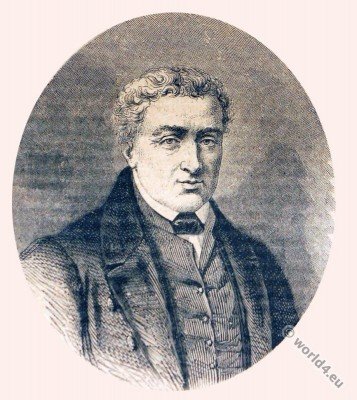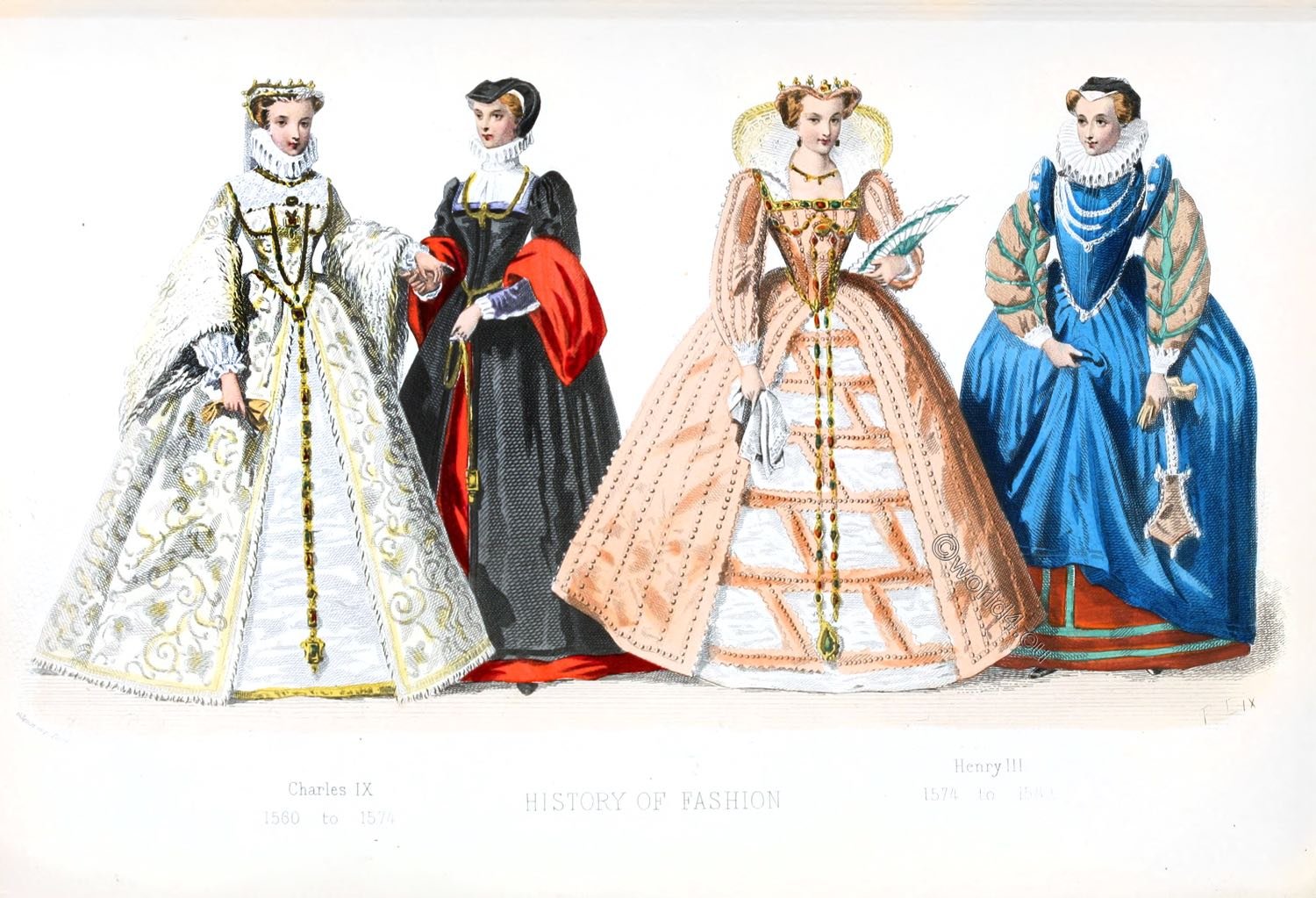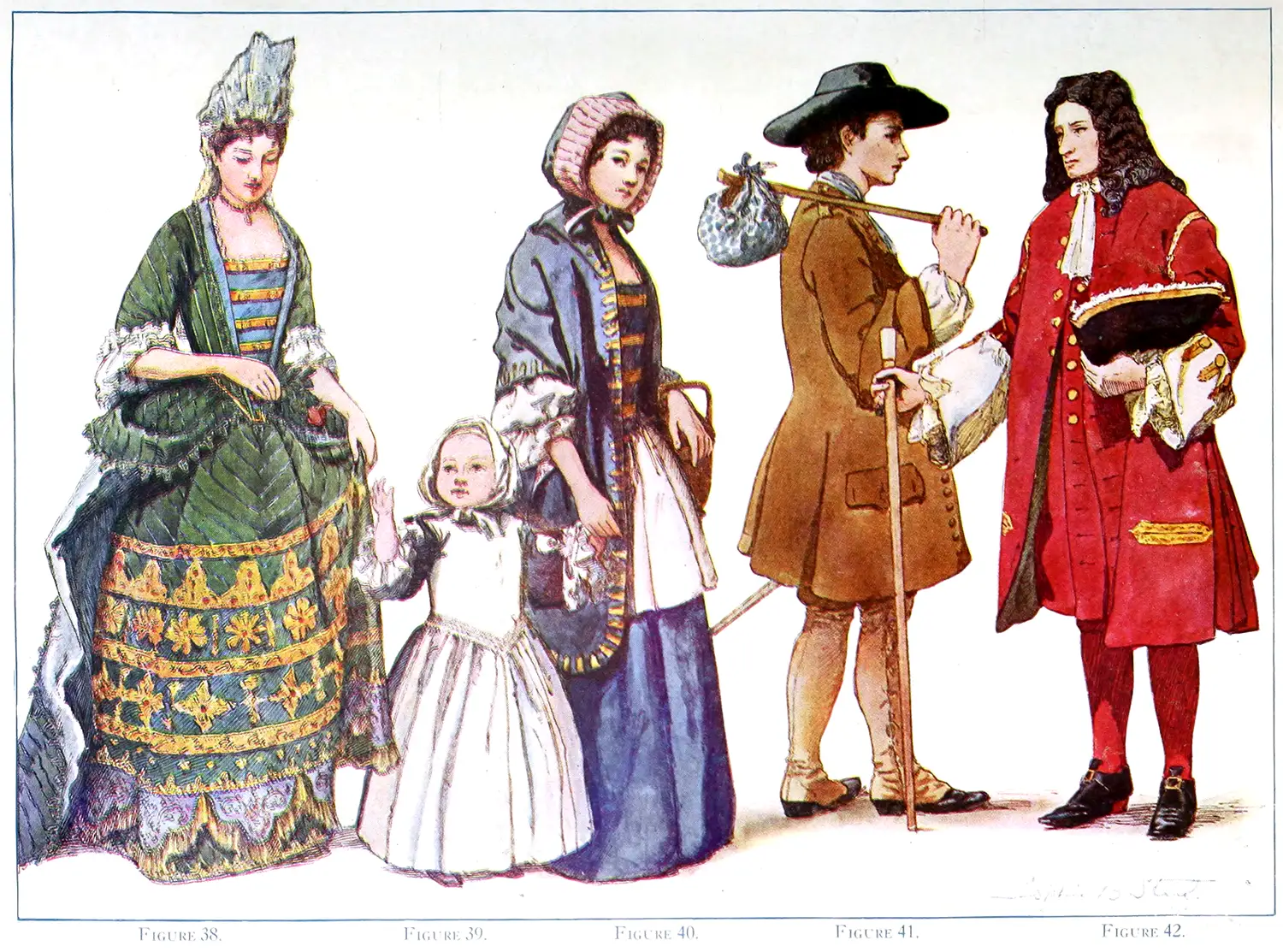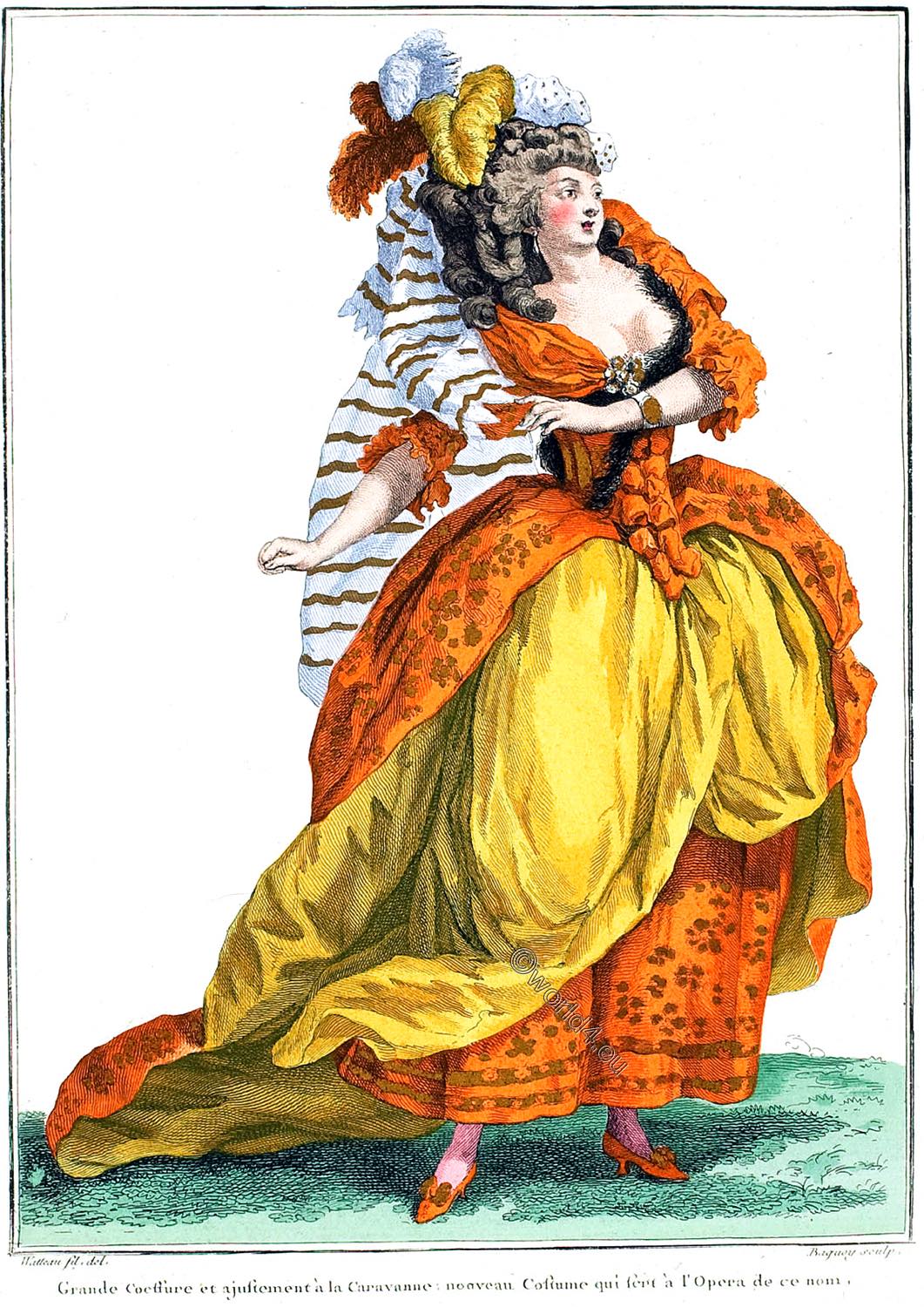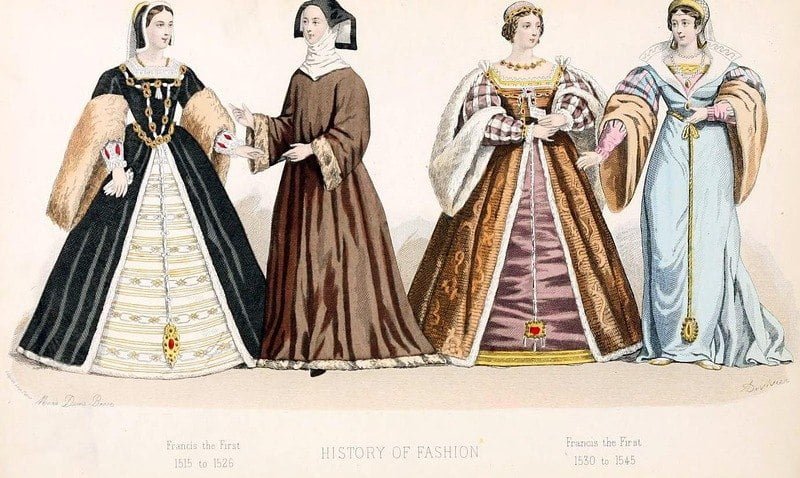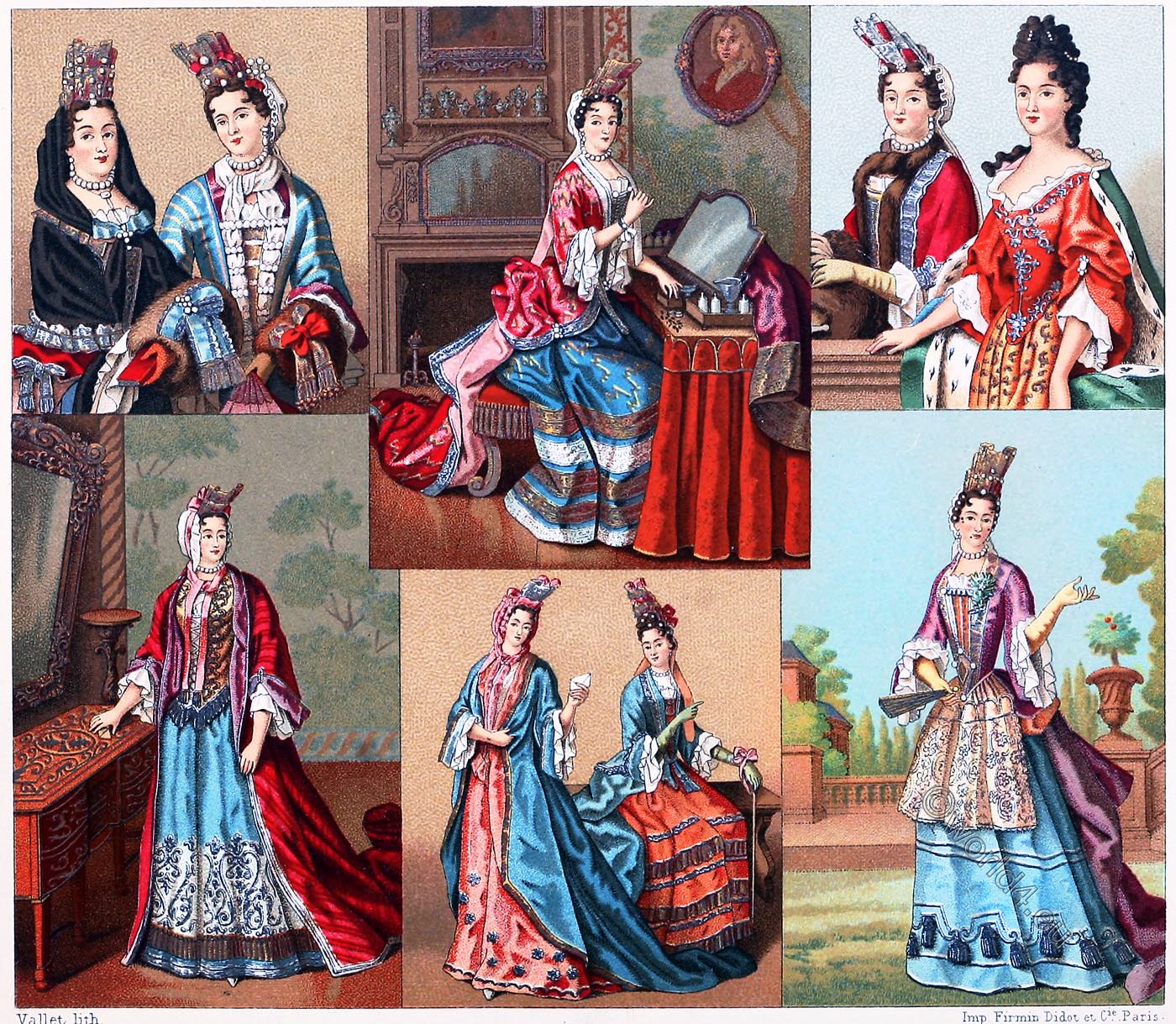
Reign of Napoleon I. 1804 to 1814. First Empire.
(England Regency, Georgian fashion period)
Content: Fashions under the First Empire — Sacks — “Personnes cossues” — A saying of Napoleon’s – White gowns — Valenciennes lace — Ball dresses; walking dresses — Polish “toquets” and bonnets — Turbans — Muslins — Artificial flowers — Wenzel’s manufactory; “The Offspring of Imposture,” Campenon’s verses — Parisian ladies, as sketched by Horace Vernet — Stays — Cashmeres — Protest by Piis — Ternaux assists in establishing the manufacture of cashmere shawls in France — Cotton stuffs — Richard Lenoir; importance of the Rouen manufacture — Violets during the Hundred Days — The “eighteen folds,” and white silk.
Fashions under the First Empire. – “Sack” dresses.
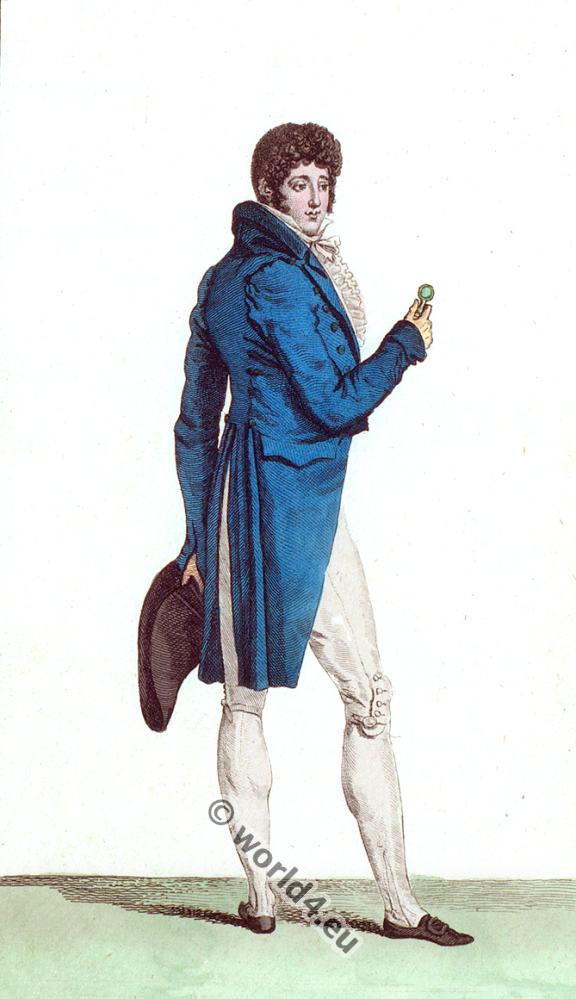


Under the Empire, which was proclaimed in 1804, the fashion of short waists continued in favour, and even developed into extraordinary results. The fair sex adopted “sack” dresses, with the waist close under the arms, and the bosom pushed up to the chin.

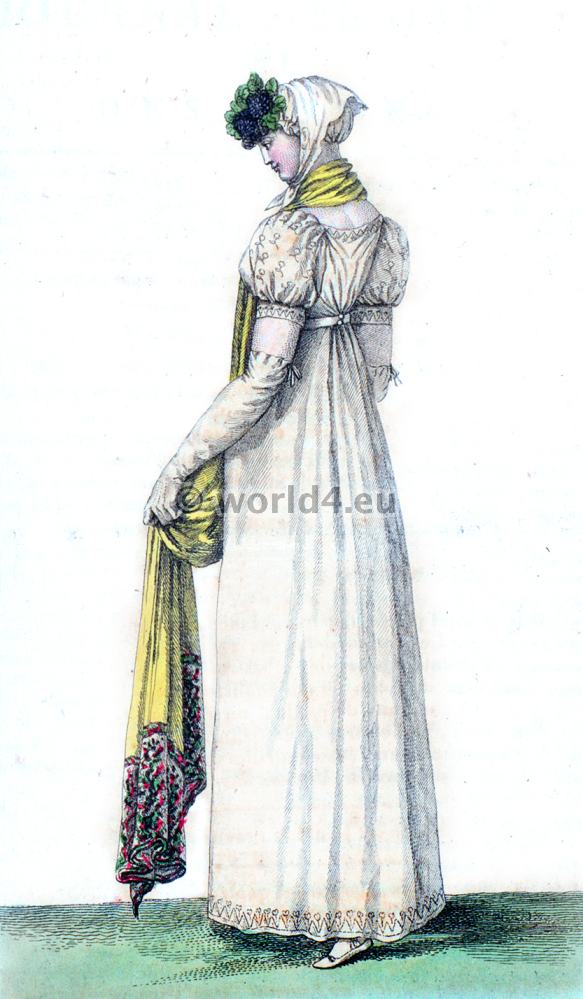
Gold, precious stones, and diamonds were lavishly used. Numerous balls were given, and official receptions held, and the dress of the women was handsome, nay, even magnificent. Unfortunately, it was chiefly remarkable for its bad taste. A Frenchwoman seemed to have attained the height of glory when it could be said of her: “Voilà une personne cossue!” (“There’s a warm, substantial person.”)
Napoleon wished his court to be splendid, and was accustomed to rebuke ladies who committed the sin of economy. “Madame la Marechale,” said he one day to a lady, “your cloak is superb; I have seen it a good many times.”
She took the hint. Extravagance prevailed in every class of society, we might almost say “By order.”
Towards the same period, Gerard’s picture of Love and Pysche (François Gérard 1770 –1837) brought pallor into fashion. Rouge was altogether abolished, white pearl-powder was universally used, and women tried to be interesting by making up their faces “à la Psyché.”
This departure from the ways of the eighteenth century did not prevent Frenchwomen from continuing to borrow some few fashions from foreign countries and other times, viz. Palatines from the north, Falbalas from the reign of Louis XV., and some minor accessories from Spain, Italy, Turkey, and England.
Valenciennes lace — Ball dresses; walking dresses.
For the most part women wore fronts instead of their own hair, and diamonds in place of flowers. They were above all anxious to show off their wealth. Many of them were parvenues who sought to do honor to their husbands’ position. Yet the white gowns with spiral trimming of pink satin, and a wreath of brightly colored flowers round the bottom of the skirt, must have been pretty. The bodice was fastened on the shoulders by many-colored ribbons, and trimmed at the neck with Valenciennes lace of great cost. The bare arms were covered with long white gloves; round the throat was a necklace of real pearls, and on the hair, worn in curls, a wreath of roses.
Such a dress as the above (post-header) was for ball-room wear; the skirt was short, revealing the ankle and foot in a white satin shoe. Walking costumes were much the same as to shape, with the exception of the skirt, which was very long. They were much heavier by reason of the kerchief round the neck, and the shawl covering the shoulders. Dresses were worn “à la Jean de Paris,” an opera by Boïeldieu;* the hair was dressed “à la Chinoise,” with gold pins, from which hung little gold balls.
* An opéra comique (comic opera) in two acts by the French composer François Adrien Boieldieu, with librettist Claude Godard D’Aucourt de Saint-Just.


Polish “toquets” and bonnets — Turbans — Muslins — Artificial flowers.
With the same style of hair, the “cap-bonnet,” trimmed with feathers, was fastened under the chin with silk strings. There were toquets of embroidered tulle, and hats “à la Polonaise,” of a somewhat ungraceful square shape; turbans also in clear muslin spotted with gold, and turban-caps, both souvenirs of the Napoleonic victories in Egypt. How many fine ladies resembled Mamelukes!
Some women wore cloth, merino, or velvet coats; and almost all excessively short waists. Their gowns were indecently low.


[
High gowns made without fulness were frequently trimmed with many rows of flounces or falbalas. From the beginning of the century, the manufacture of muslin, which is said to be so named from the town of Mossoul, had been greatly developed at Tarare and St. Quentin.
In addition to this, the principal innovation of the period was the definitive introduction of artificial flowers, which, until then, had only been occasionally employed in feminine attire.


The Italians had long possessed the art of producing artificial flowers, and had practised it with great success; but in France this branch of industry had only been introduced in the year 1738. A man named Séguin, a native of Mende, and a very clever chemist and botanist, succeeded in manufacturing artificial flowers quite equal to those of Italy. He also made them after the Chinese method, from the pith of the elder-tree; and he was the first to invent a sort of flower made of silver-leaf, which has been much used to ornament feminine attire.
Wenzel, a maker of artificial flowers in various materials, who received an award at the Industrial Exhibition in 1802, sold very admirable specimens of his art, and greatly contributed to the success of artificial flowers when employed for the dress or hair. Flowers were worn mingled with braids of false hair.
Philippe de la Renaudière dubbed these “the offspring of imposture.” Campenon, in his “Maison des Champs,” exclaimed,—
“Oui, loin des champs, il est une autre Flore,
Que I’art fait naitre et que Paris adore…
Sur ces bouquets méconnus des zephirs,
Un pinceau sur adroitemont dépose
L’or du genet, le carmin de la rose,
Ou de I’iris nuance les saphirs;
Puis on les voit dans nos foUes orgies,
Au sein des bals, loin des feux du soleil,
S’épanouir aux rayons des bougies.
L’art applaudit à leur éclat vermeil;
Mais sur ces fleurs, enfants d’une autre Flore,
Je cherche en vain les p’eurs d’une autre Aurore.”
(“Yes, far from fields there is another Flora,
Born of art, and adored by Paris…
Upon nosegays of which zephyrs know nothing,
A skilful brush lays cunningly
The gold of the gorse, the carmine of the rose,
Or the sapphire tints of the iris;
And then we see them, amid our orgies,
In the ball-room, far from the sun-rays,
Bloom in the glare of the wax lights.
Art applauding their brilliancy;
But on those flowers, children of another Flora,
In vain I seek the tears of another Aurora.”)
The art of flower-making has made some progress since 1738 and 1802, and it may be said that artificial flowers are indispensable to an elegant costume.
Parisian ladies, as sketched by Horace Vernet – Stays — Cashmeres.
The Empire was the period of “toquets” in embroidered tulle. Horace Vernet, the great painter, although very young in 1813, has portrayed “Les Dames de Paris” in the reign of the first Napoleon. Nothing seems to us more hideous than their hats and feathers, their sleeves tight to the wrist, and the embroidery on their gowns.
Mme. de Staël’s “Corinne” turned the heads of the fair sex in 1807 and 1808. They assumed an inspired expression, fancied themselves on Italian shores, played on the harp, and wore scarfs that floated with every breeze.




The fashions of the Empire have been much, yet on one important point, perhaps, not sufficiently criticized. We allude to the use of stays, which came in with the winter of 1809, and have held their place ever since, in spite of all the sarcasm that has been lavished on those mechanical aids to dress. By way of compensation, the Empire gave us Cashmere shawls, first brought into France at the time of our Egyptian expedition (1798—1802). Previously to that, Tippoo-Saïb had included shawls among the gifts he had sent to Louis XVI.; but they were not generally worn until later.
Protest by Piis.
Piis (Pierre-Antoine-Augustin 1755 – 1832, chevalier de Piis, French dramatist.) wrote the following lines on the subject:
“D’ailleurs, ces schalls si solides,
Que vous portez à l’envi,
A des Arabes perfides
De ceintures ont servi.
Ah! de ces tissus profanes
Comme à mon tour je rirai,
Si le goût des caravanes
Par eux vous est inspiré.”
(“Besides, those heavy shawls
Which you delight in wearing,
Have previously served for girdles
To perfidious Arabs.
Ah! at those profane fabrics
I should laugh in my turn.
If in theirs they inspired you
With the taste of the caravans.”)
Ternaux assists in establishing the manufacture of cashmere shawls in France, First Empire.
Cashmere shawls are so called from the capital of a province in Asia, within the territories of the Great Mogul. About 100 000 shawls were made yearly in Kashmir.
Guillaume Louis Ternaux was the first to imitate the famous Indian shawls, and then conceived the idea of naturalizing in France the Tibet goats, whose hair had hitherto been exclusively employed in their manufacture. For this purpose, and at great cost, he despatched M. Joubert, of the National Library, who was well acquainted with the Oriental tongues, to Tibet. M. Joubert gathered together a flock of 1500 goats, only 256 of which reached France, and were distributed over the southern provinces. Thanks to Ternaux, Cashmere shawls have become one of the most splendid adornments of feminine dress. On their first appearance they delighted both Paris and the provinces. Their marvelous texture, consisting principally of the soft hair of acclimatized Tibet goats, elicited universal admiration.
At first no French manufacturer ventured to imitate so delicate a tissue, such extraordinary lightness, such curious patterns; but after a time an attempt was made to reproduce Tibet cashmeres by means of cotton, silk, and wool, which, however, were found to be wanting in softness. At a later period the hair of Kirghis goats from Russia was successfully employed, and thus a sufficient softness was obtained for the “French cashmeres.”
The sway of cashmeres has its vicissitudes and lapses. For awhile they vanish from the scene, and then, after an interval, they regain their well-deserved place in the public esteem. When an occasion arises on which very grand and imposing attire is required a woman of fashion buys one of those splendid products of the Indies.
At solemn family gatherings, a cashmere is indispensable; it proclaims the wealth of the wearer.
François Richard-Lenoir 1765-1839 was a French manufacturer of industrial fabric, which became one of the leading cotton merchants in the early 19th century.
The cotton manufactures of France were of little importance until 1787, in which year the Government set up spinning machinery at Rouen; but the manufacture began to flourish only under the First Empire, when the energy of Richard Lenoir contributed greatly to its success. From the time that machinery was substituted for the old spinning-wheel, an amount of labour which formerly employed a thousand spinners could be accomplished by a mere child. For more than sixty years the colored cottons manufactured at Rouen, and called in consequence “Rouenneries,” have served to clothe the majority of Frenchwomen.
Violets during the Hundred Days — The “eighteen folds,” and white silk.
During the Hundred Days, succeeding the return of Napoleon from Elba, violets became the fashion. They were regarded as a political emblem. From May 20, 1815, no Imperialist lady appeared in public without a large bunch of violets on her breast. Some morning caps were trimmed with violets and immortelles side by side, and several jewellers manufactured ornaments of the same design. On the other hand, the Royalist ladies wore jaconet gowns with eighteen tucks in the skirt, in honour of Louis XVIII., and bonnets of white silk striped with plaited straw, a small square cashmere shawl with a vermilion border, and dark blue prunella boots.
Source: The history of fashion in France, or, The dress of women from the Gallo-Roman period to the present time by Augustin Challamel, Frances Cashel Hoey, John Lillie. Publisher: New York, Scribner and Welford, 1882.
Related
Discover more from World4 Costume Culture History
Subscribe to get the latest posts sent to your email.




